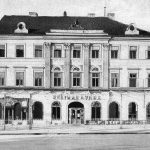Did you know that Zagreb used to have its very own riviera?
Even though it might not look like it nowadays, the embankment of the Sava River used to be a popular bathing spot.

1910
Back in 1859, Franz Hutterer, an Austrian merchant and an owner of a bathing raft in Vienna, was given concession over a strip of land next to the river. The bathing place was located on a 24-metre raft connected to the land with a rope, and it had 8 big and 2 small cabins, as well as nets, a kind of “swimming baskets.”

1928
In 1928 it was officially made into a beach, which had about 900 cabins and 3 pools on the raft, there was a restaurant next to it, and you could rent sunbeds.There was a separate section intended for women only, popularly called Babinjak. The place was so popular that there was even a beauty pageant, crowning the most beautiful woman at Sava beach.

1929
Later it was turned into the first sunbathing spot for nudists in Zagreb, and one of the rare nudists beaches in Europe at the time.

1929

1930s
The beach was so popular that there were up to 10 thousand people there on weekends.

1950
It was divided into two parts: the left side was private and more expensive, known as “Gospodarićevo kupalište,” and the right side was public. The Sava Riviera stretched from present-day Jadranski most all the way to Jarun and it was filled with people playing tennis, volleyball, chess, or just strolling around because it was the “it” place to be.

1930s

1934
In the ‘60s, the Sava became too polluted because of the coal from the Trbovlje mine in Slovenia, so it was turned into a sunbathing-only spot.

1960s
The wooden houses soon started to decay, and even though citizens fought for the beach to be renovated and repurposed, and expert opinions given by architects stated that it was to be protected as a cultural monument, all the wooden structures burnt down in 1993.

1983
There have been various suggestions to renovate the place and add spaces with new functions, such as galleries, studios, or cinemas, but, unfortunately, none of them have been taken into serious consideration.
The beach was featured in Tko pjeva zlo ne misli (“One Song a Day Takes Mischief Away”), a 1970 comedy/drama, widely considered to be one of the best Croatian films ever made.
All photos from Zagreb – kakav je bio nekada Facebook Group.











